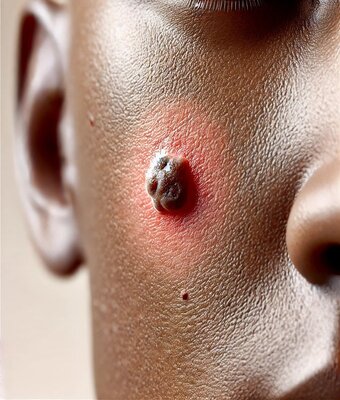
Is an Itchy Mole a Cause for Concern?
Moles are a completely normal occurrence and should not pose any problem or require any treatment. However, it’s a good idea to keep an eye on them. If a mole starts itching or changing color and shape, it’s best to have it checked regularly.
How to Tell the Difference Between Common and Atypical Moles
Most moles are benign and will stay that way. A standard mole is usually:
- Flat or slightly raised
- Round or oval-shaped
- Tan, brown, skin-toned, blue, red, pink, or translucent
- Smaller than a quarter inch (5 mm) across
- Clearly bordered from the surrounding skin
- Atypical moles, on the other hand, have some distinct differences. They may:
- Be larger than a quarter inch (6 mm)
- Have an irregular or fading border
- Show multiple colors within the same mole
- Have a surface that’s rough, flaky, bumpy, or uneven
If you have more than 50 moles, your risk of developing skin cancer is slightly higher, so regular skin checks are a good idea.
Why Do Moles Itch?
An itchy mole isn’t always a red flag. Itching is often caused by irritation—things like dry skin, sunburn, or certain skincare products can trigger it. However, if the itching is persistent or accompanied by other changes, it’s worth getting checked.
When to See a Dermatologist
If a mole starts to itch and also changes in:
- Size
- Shape
- Color
- Texture
…or if it becomes painful, tender, or begins to bleed, it’s time to book an appointment. Mole removal might be recommended if there’s a concern about skin cancer.
Signs of a Malignant Mole: The ABCDE Rule
Dermatologists use the ABCDE method to spot potential melanoma:
Asymmetry – One half of the mole doesn’t match the other.
Border – The edges are irregular, ragged, or blurry.
Color – It has multiple colors rather than one uniform shade.
Diameter – It’s larger than a quarter inch (6 mm).
Evolving – It’s changing in size, shape, or texture.
If you notice any of these, schedule a skin exam with a dermatologist.
Could Itching Be a Sign of Skin Cancer?
Most skin cancers, including basal cell carcinoma (BCC) and squamous cell carcinoma (SCC), are treatable when caught early. Around 40% of patients with BCC or SCC report itching, which usually stops after treatment. Melanoma, the most serious form of skin cancer, doesn’t typically cause itching—but any changes in a mole should always be checked.
Take a Moment to Check Your Skin
While you’re getting dressed or showering, take a few seconds to check in with your skin. If you spot anything unusual, don’t wait—catching things early can really make a difference. If you’re worried about a mole or any changes, our London dermatologists are here to help. Book a consultation today and get the peace of mind you deserve.


